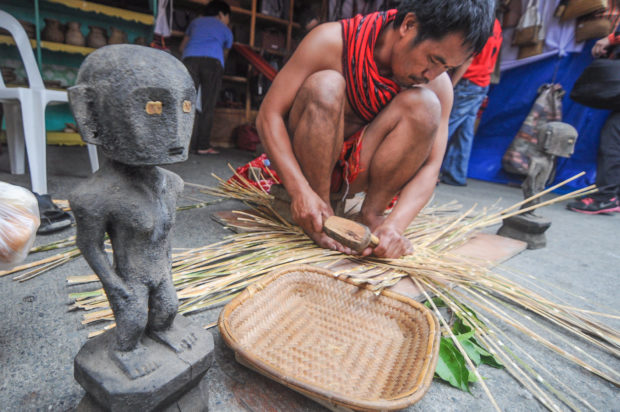Selling ‘bu’lul’ nearly changed Ifugao lives

GODS FOR SALE Once meant only for agriculture, “bu’lul” statues have become souvenirs for tourists, much like the baskets woven for visitors of Ifugao’s rice terraces. —KARLSTON LAPNITEN
KIANGAN, Ifugao — In December 2015, an Ifugao artifact owned by a New York collector sold for the equivalent of P1.95 million at an auction in Paris.
But few people who participated in that auction may have been aware that what had been sold was a god.
The “bu’lul di Namtogan” (god of Namtogan), 69 centimeters in height, could have been one of the deities and spirits that have long held sway over the Ifugao and their rice terrace culture.
The Ifugao believe that about 2,000 deities have great influence on every aspect of their life, from birth to death. Of these deities, the bu’lul are the only divine beings that are represented in stone or wood, in which they dwell.
Human characteristics
The more familiar statues were patterned after the bu’lul carved by Taguiling, who first gave the carvings their detailed human characteristics. Taguiling was a 19th century woodcarver from Barangay Cababuyan, Hingyon town, Ifugao province.
Typical bu’lul are depicted standing or hunched with arms clasping their knees like Namtogan.
Some bu’lul have glass or shells for eyes and tufts of hair attached to their wooden head. The town of Kiangan, considered the cradle of Ifugao culture, has a unique “dancing” bu’lul, with its arms stretched sideways.
Ages ago, the economic stature of a village relied on the good graces of the bu’lul, according to Marlon Martin, chief operating officer of Save the Ifugao Terraces Movement (Sitmo), a cultural advocacy group.
“Rituals need to be performed by ‘mumbaki’ (priests) in every phase of the agricultural cycle so the community can receive a bountiful harvest,” Martin said.
After the rituals, the bu’lul are placed inside the house or the “alang” (rice granary) to serve as sentinels. The bu’lul can also be invoked to heal a loved one.
If a bu’lul is neglected, a person or an entire clan can suffer “kalat di bu’lul” (curse of the god), which comes in the form of a degenerative disease or is experienced through unending misfortune that is passed down to the next generations.
Gods for sale
At the start of the 1900s, Americans started buying artifacts to satisfy their curiosity, having just acquired the Philippines from Spain.
Many antique and heirloom bu’lul ended up in the possession of private collectors and ethnographic museums.
American collector John Kuiper, for example, has 82 bu’lul, classified as “authentic artifacts used for traditional purposes” based on a certificate of registration of cultural property issued by the National Museum of the Philippines.
Poverty and the introduction of Christianity made it easy for some Ifugao families to give up their heirloom articles. Many of them depended on the heirloom grains called “tinawon,” which are grown on rice terraces only once a year, according to Manuel Cayong, an elder and broker of artifacts from Hingyon.
“Families gave up [their bu’lul] when they embraced Christianity and got the money they needed,” said Cayong, who also used to make souvenir items.
He said he lost count of the number of bu’lul he helped sell since 1972.
A controversial point of view still expressed here is that Christianity had saved bu’lul owners from performing rituals that left them impoverished. Many rituals required expensive animal sacrifices and feasts.
The sale of artifacts helped young Ifugao earn professional degrees.
Martin said his grandparents sold their ancestral stone bu’lul and made enough money to pay for the education of his mother and her siblings.
Fake gods
Artifact hunting was briefly hampered when fake bu’lul surfaced in the 1990s, said a former antique dealer from Diffun town in Quirino province.
The dealer, who did not want to be named, said he sold about 50 bu’lul as well as “pun’amhan” and “tingab”—wooden boxes used by mumbaki in performing rituals.
His most popular items sold were the standing bu’lul from Banaue town, one of which was bought by a French doctor for P925,000 in 1995.
He said he gave up the trade in 2005 after his clients began to buy artifacts directly from Ifugao villagers.
Twenty years of antique hunting also forced him to seek the help of mumbaki to undo “curses” he believed he acquired from selling bu’lul.
Many old bu’lul carvings being sold today have not been used or consecrated by mumbaki, said Martin, who is the steward of his family’s remaining bu’lul.
Genuine antiques in good condition can go for up to P1 million, he said, as these hav been passed down from generations and required their owners to pay for lavish rituals to remove their sacred character.
Deconsecrating or retiring a bu’lul also means a host family must build and ritually cleanse a new statue, which becomes the deity’s new dwelling place.
Today some families still perform the rituals, often to cure ailments, said Fr. John Habawel, parish priest of St. Mary Magdalene in the Ifugao capital of Lagawe.
Habawel said the belief in the powers of bu’lul and other worldly beings was not easy to ignore.
The Catholic Church, he added, has taken pains to teach communities that rituals, spirits and the bu’lul should be cherished as part of their rich culture and history.














